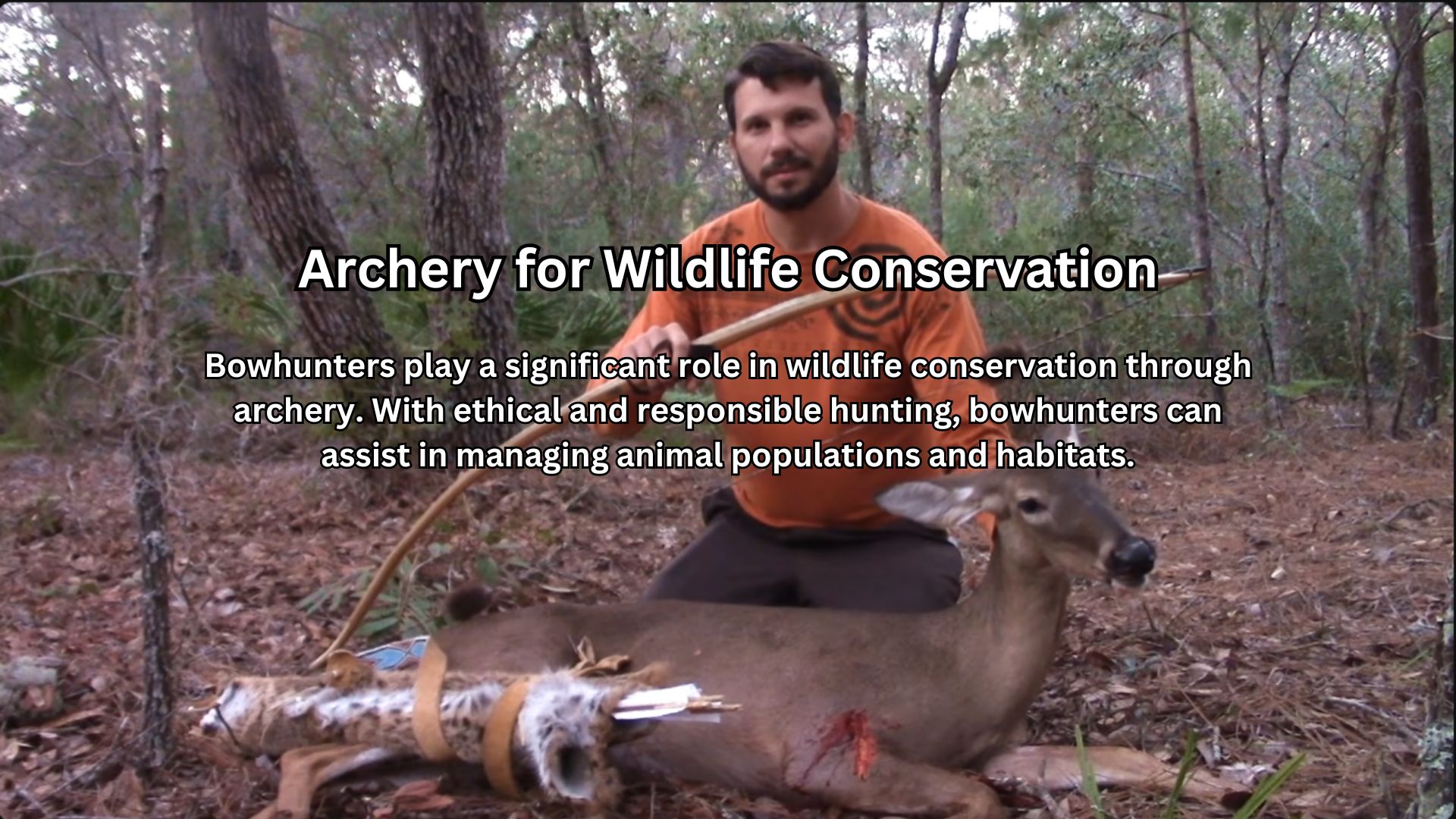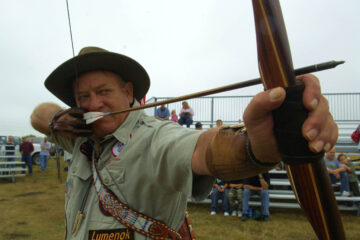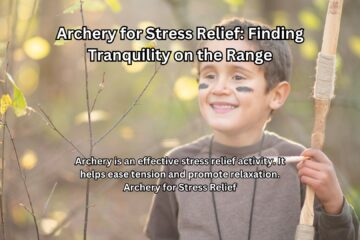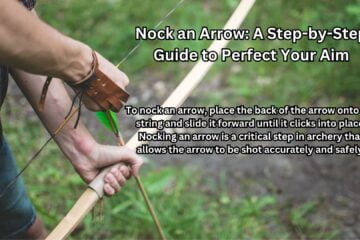Bowhunters play a significant role in wildlife conservation through archery. With ethical and responsible hunting, bowhunters can assist in managing animal populations and habitats.
Archery for wildlife conservation has become a popular approach to balancing the ecosystem, and bowhunters have played a crucial role in this approach. It is not just about hunting; it is about controlling animal populations that may damage habitats, decreasing inappropriate activity, reducing vehicle-animal collisions, and even helming put food on the table through hunting.
Bowhunting is known for its precision and skill, and with the advent of newer technologies, hunting has become more ethical and humane. Hunters today aim for quick and accurate kills as possible. In this article, we will examine the critical roles bowhunters play in wildlife conservation.
Archery For Wildlife Conservation: The Role Of Bowhunters
Archery has been around for centuries and has served as both a sport and a way of hunting. Nowadays, many bowhunters have taken up the cause of wildlife conservation to protect natural habitats for animals. Their role in wildlife conservation cannot be overlooked.
In this post, we’ll discuss the importance of archery in conserving wildlife and how bowhunters play a significant role in this endeavor.
Archery For Wildlife Conservation: Protecting Natural Habits:
- Bowhunting is an eco-friendly practice that helps maintain the natural balance of wildlife populations. By carefully controlling the number of animals that are hunted, bowhunters prevent overpopulation, which can lead to disease and starvation.
- Bowhunting is also a sustainable method that helps protect natural habitats for animals. By hunting wildlife, bowhunters reduce the risk of overgrazing and deforestation, which can destroy habitats and lead to the extinction of certain species.
Benefits Of Bowhunting For Wildlife Conservation:
- Bowhunting promotes ethical and responsible hunting practices. Bowhunters spend years honing their skills to ensure that they have a clean and ethical kill, reducing suffering for animals and preserving their dignity.
- Bowhunting also helps to raise funds for wildlife conservation through licenses and permits. These funds go towards supporting research, habitat protection, and other conservation efforts.
- Bowhunters work closely with wildlife biologists to manage and maintain healthy animal populations. They use their knowledge of animal behavior and natural habitats to protect and conserve wildlife.
The Role Of Bowhunters In Protecting Endangered Species:
- Bowhunters play an essential role in protecting endangered species by helping to control their populations. By hunting carefully and responsibly, bowhunters can help prevent the extinction of endangered species.
- Bowhunters also support conservation efforts by providing important data to wildlife biologists. They keep detailed records of the animals they hunt, including information on age, health, and location. This data helps researchers to better understand animal populations and inform conservation strategies.
Archery plays a significant role in wildlife conservation, and bowhunters are at the forefront of this effort. Their careful and ethical approach to hunting helps to protect natural habitats, maintain healthy animal populations, and prevent the extinction of endangered species.
Bowhunting is a sustainable and eco-friendly practice that supports wildlife conservation efforts and helps to ensure that future generations can enjoy the natural beauty of our planet.
The History Of Bowhunting And Its Role In Wildlife Conservation
Archery has been around for thousands of years, initially used to hunt food and protect oneself from predators. As technology advanced, bowhunting evolved into a recreational sport. However, hunting with a bow can be a potent wildlife management tool, providing benefits that firearms cannot.
In this section, we will explore the history of bowhunting, its evolution, and its role in wildlife conservation.
Early Use Of Bows In Hunting
- Bows and arrows are among the earliest tools used by humans, with evidence of bow use dating back more than 10,000 years.
- Bows became essential hunting tools, especially when hunting migrations of wild game.
- Early bows were made from simple materials such as wood, bone, and sinew.
Evolution Of Bowhunting
- The invention of composite bows around 3,500 years ago revolutionized bow hunting, increasing the accuracy and range of bows.
- In medieval times, bows were a significant weapon in warfare and hunting.
- The Industrial Revolution brought many advancements in hunting technology, and bowhunting became less popular.
- As conservation became a more prominent issue in the early 1900s, bowhunting gained popularity once again as a more ‘primitive’ and sustainable form of hunting.
Introduction Of Bowhunting As A Conservation Tool
- Bowhunting is a highly selective form of hunting due to the short range and accuracy required, making it less dangerous to non-target species.
- Bowhunters are also more likely to follow ethical hunting practices and regulations out of respect for the sport.
- Bowhunting can be used to manage wildlife populations, such as culling overpopulated deer herds to prevent habitat destruction and human-wildlife conflict.
- Bowhunting revenue is often used to fund conservation efforts and support wildlife management programs.
Even though bowhunting was initially used for subsistence purposes, it evolved into a sport and steadily acquired a conservation aspect. Bowhunters play an essential role in managing wildlife populations and preserving valuable ecosystems.
The Scientific Approach Of Bowhunting For Conservation
Archery For Wildlife Conservation: The Role Of Bowhunters
Bowhunting is a science that has been used for centuries to control wildlife populations, preserve ecosystems, and promote a healthy balance of fauna in nature. Bowhunters are skilled individuals who take a careful, calculated approach to hunting animals with a bow and arrow.
In this post, we’ll explore the scientific approach of bowhunting for conservation and examine its role in wildlife preservation.
Bowhunting As A Science
Bowhunting is not just a sport or a hobby; it is a science that requires patience, knowledge, and skill. Bowhunters must know the anatomy and behaviors of the animals they hunt, as well as the environment in which they live.
This knowledge allows them to take shots that are quick, efficient, and humane, resulting in a clean kill.
Bowhunting is also a form of resource management that helps control wildlife populations. When done correctly, it can prevent overpopulation, reducing the risk of disease and starvation among animals. In turn, this promotes biodiversity and helps maintain a healthy ecosystem.
Benefits Of Bowhunting As A Conservation Tool
Bowhunting is a powerful conservation tool that offers numerous benefits to wildlife and their habitats. Some of the key benefits of bowhunting as a conservation tool are:
- It promotes selective harvesting, allowing hunters to target specific animals, such as older or weaker individuals, which helps maintain a healthy population.
- The use of bows and arrows in hunting is quieter and less invasive than firearms, allowing hunters to get closer to their prey without disturbing other animals in the area.
- Bowhunting can stimulate local economies in rural areas, creating jobs and generating revenue for local businesses.
- It helps fund conservation efforts through the collection of hunting fees, which are often reinvested into wildlife preservation and habitat restoration.
How Bowhunting Is Regulated And Monitored For Conservation
Bowhunting is regulated by state and federal agencies, which monitor and manage wildlife populations to ensure their survival. There are strict rules and regulations governing bowhunting practices to prevent overhunting and the endangerment of species.
Bowhunters must obtain a hunting license, which requires them to pass a written and/or practical exam and adhere to strict hunting seasons and bag limits. These regulations ensure responsible hunting practices, prevent overhunting and protect vulnerable species.
In addition, bowhunting is often monitored and studied by wildlife biologists and conservationists, who use it as a tool for scientific research. These studies help us understand how hunting affects wildlife populations and their environments, providing valuable insights into how we can better manage and preserve our natural resources.
Bowhunting is an important conservation tool that has been used for centuries to promote wildlife preservation and resource management. As a science, bowhunting requires patience, knowledge, and skill, and when done responsibly, it can offer numerous benefits to both wildlife and the communities that rely on them.
Through careful regulation and monitoring, we can continue to use bowhunting as a tool for preserving our natural resources for generations to come.
The Contribution Of Bowhunting To Wildlife Conservation
Archery For Wildlife Conservation: The Role Of Bowhunters
Bowhunting may seem like a questionable activity to some, but it has an essential role to play in wildlife conservation. Bowhunters help control overpopulation, aid in wildlife management, and even provide economic benefits to the surrounding areas. We’ll discuss how bowhunting positively impacts wildlife conservation efforts.
Bowhunting And The Control Of Overpopulated Wildlife
Bowhunting plays a vital role in controlling overpopulated wildlife, which can eventually lead to habitat destruction, disease, and starvation. Here are some key points to consider:
- Overpopulated wildlife can cause significant damage to ecosystems, including soil degradation, erosion, and habitat destruction.
- Bowhunting helps regulate the number of animals in a given area, ensuring that they have enough resources to survive without causing damage.
- Bowhunting, when done correctly and responsibly, can be a humane way of controlling populations.
The Role Of Bowhunters In Wildlife Management
Bowhunters have a key role in wildlife management, as they are often more invested in conservation efforts than others. Here are some points to consider:
- Bowhunters invest heavily in wildlife conservation efforts and are often leaders in advocating for conservation policies.
- Bowhunters help monitor and maintain population numbers in their hunting areas, making sure that wildlife populations do not harm the ecosystem while also making sure that hunting remains sustainable.
- Bowhunters participate actively in land management decisions that affect wildlife habitats, ensuring that habitats remain suitable for the wildlife they hunt.
The Economic Benefits Of Bowhunting On Wildlife Conservation
Bowhunting provides significant economic benefits to the surrounding areas, which can help fund conservation efforts. Here are some key benefits to consider:
- Bowhunting generates revenue for states and local communities through licenses, hunting taxes, and tourism.
- Bowhunters invest heavily in high-quality hunting equipment, such as compound bows, arrows, and tree stands, providing a boost to the local economy.
- Bowhunting, when done sustainably, ensures that habitats and wildlife remain healthy, ensuring a long and viable hunting season for bowhunters.
Bowhunting has a vital role to play in wildlife conservation. Bowhunters help control overpopulation, aid in wildlife management, and even provide economic benefits to the surrounding areas. When done correctly and responsibly, bowhunting can be a humane way of controlling populations and maintaining the health and viability of ecosystems.
Bowhunting And Sustainable Use Of Wildlife Species
Archery For Wildlife Conservation: The Role Of Bowhunters
Bowhunting is a perfect blend of tradition, skill, and passion for hunters who love to engage with nature and wildlife. Bowhunters have always played a vital role in wildlife conservation through their efforts and dedication towards sustainable use of wildlife species.
The Principles Of Sustainable Use In Conservation
Sustainable use of wildlife species refers to the responsible utilization of animals or plants in ways that maintain their populations at healthy levels. Some key principles of sustainable use in conservation are:
- Use of natural resources in a way that does not deplete future stocks.
- Use of renewable resources should not exceed their ability to renew.
- Harvesting of natural resources should be balanced with the maintenance of ecosystem health.
- Sustainable use must meet the needs of people while ensuring the long-term survival of wildlife species.
Benefits Of Bowhunting For Sustainable Use Of Wildlife
The technique of bowhunting creates an opportunity to maintain and manage wildlife populations. Here are some of the ways bowhunting helps to ensure the sustainable use of wildlife species:
- Bowhunting provides an ideal method to control the population of game animals. The state-managed bag limits are adjusted to ensure that the population does not become too large or too small.
- Hunting fees and licenses sold to bowhunters provide a significant source of revenue for wildlife management programs.
- Bowhunting helps to maintain the genetic diversity of game animals, which is essential for their long-term survival.
- Wildlife managers work with bowhunters to ensure that game animals are harvested in a sustainable manner, taking into account the specific needs of individual species.
How Bowhunting Contributes To The Long-Term Survival Of Wildlife
Bowhunting has proven to be an essential tool for the management of game populations and the conservation of natural habitats. Here are some ways in which bowhunting contributes to the long-term survival of wildlife:
- Bowhunting helps to prevent overpopulation of game animals, which can lead to disease, habitat destruction and diminished food supplies.
- Harvesting game animals through bowhunting helps to ensure that the healthiest and strongest animals survive to reproduce. This results in better genetic diversity, stronger offspring, and healthy populations.
- Bowhunting encourages the conservation of natural habitats and promotes ecosystem health, which ensures long-term survival of wildlife species.
Bowhunting provides an excellent opportunity for wildlife conservation enthusiasts to engage with nature while contributing to the sustainable use of wildlife species. Through adherence to principles of sustainable use, benefits & contributing to the long-term survival of wildlife, bowhunting proves to be an immensely valuable activity for the entire community.
Frequently Asked Questions On Archery For Wildlife Conservation: The Role Of Bowhunters
Is Bowhunting Important For Wildlife Conservation?
Yes, bowhunting can contribute to wildlife conservation by helping manage animal populations. By targeting specific animals, bowhunters can help reduce overpopulation and prevent habitat damage.
How Does Bowhunting Benefit Wildlife?
Bowhunting can benefit wildlife by keeping animal populations at sustainable levels and preventing overgrazing or crop damage. It can also generate revenue for conservation programs through hunting licenses and fees.
Are Bowhunters Skilled Marksmen?
Yes, bowhunters must train extensively to develop the skills needed to take accurate shots at animals. This includes a deep understanding of animal behavior and anatomy, as well as the ability to shoot accurately from a variety of distances and angles.
What Is The Role Of Bowhunters In Conservation Education?
Bowhunters can play an important role in educating others about the benefits of wildlife conservation. They can share their knowledge about the importance of managing populations, protecting habitats, and supporting conservation programs.
How Can Bowhunting Be Done Sustainably?
Bowhunting can be done sustainably by adhering to strict regulations and guidelines, such as bag limits, hunting seasons, and minimum age requirements. Bowhunters can also work with landowners and conservation organizations to ensure that their hunting practices are environmentally responsible.
Conclusion
As we come to the end of our journey exploring the role of bowhunters in wildlife conservation, it becomes increasingly clear that more and more people are embracing this age-old activity as a tool for preserving our natural habitats. The success stories of bowhunting and its contribution to wildlife conservation are numerous, and the benefits that come with adventure, exploration, and self-discovery that go hand in hand with bowhunting have played a huge role in its popularity.
As we continue to advocate for responsible bowhunting practices and wildlife conservation initiatives, bowhunting will no doubt continue to be one of the most effective tools in preserving our natural habitats and protecting our planet’s wildlife. With a renewed emphasis on community-led conservation efforts, we can all take part in preserving our natural environment.
So, let’s take up the bow and arrow and make a difference together!







